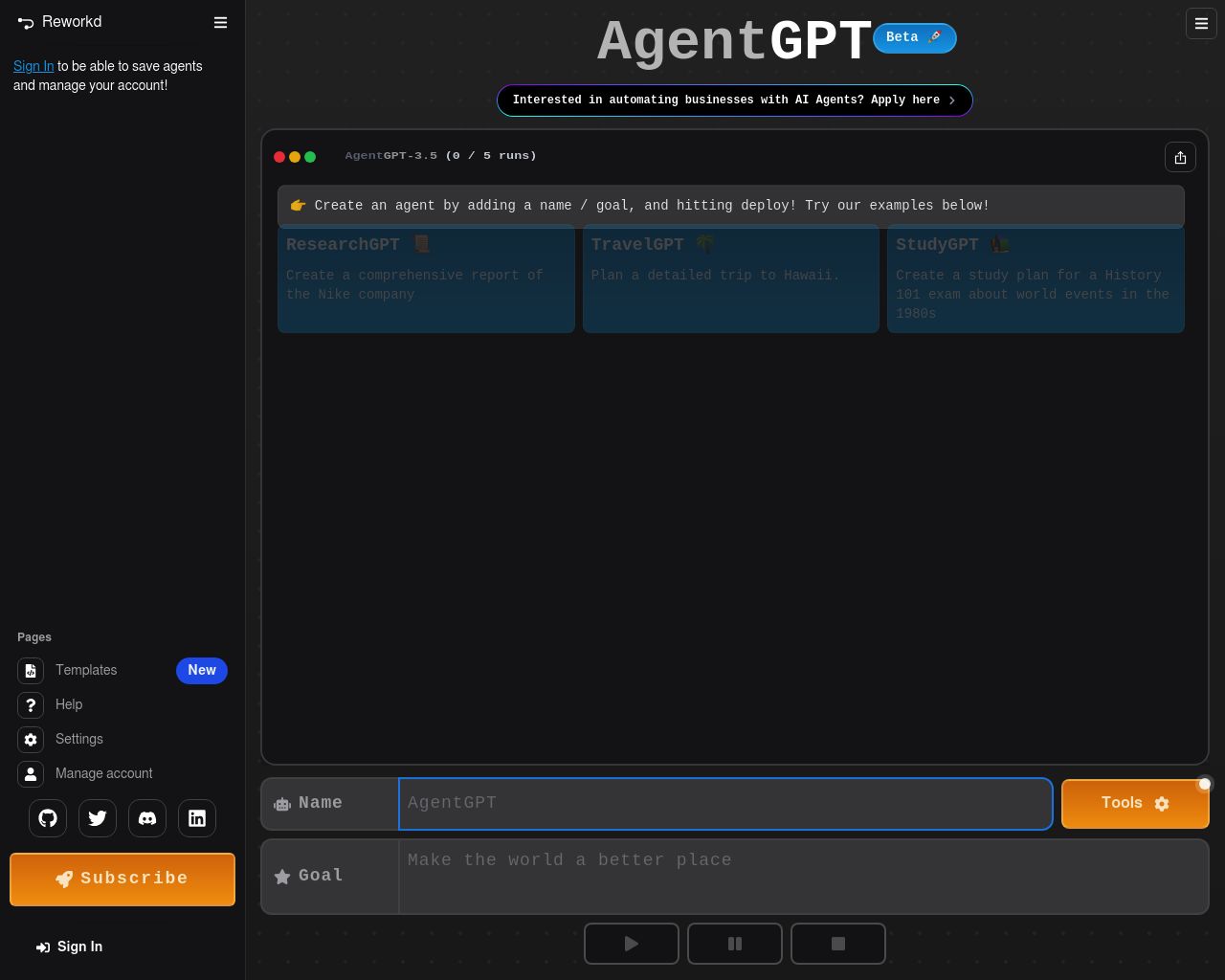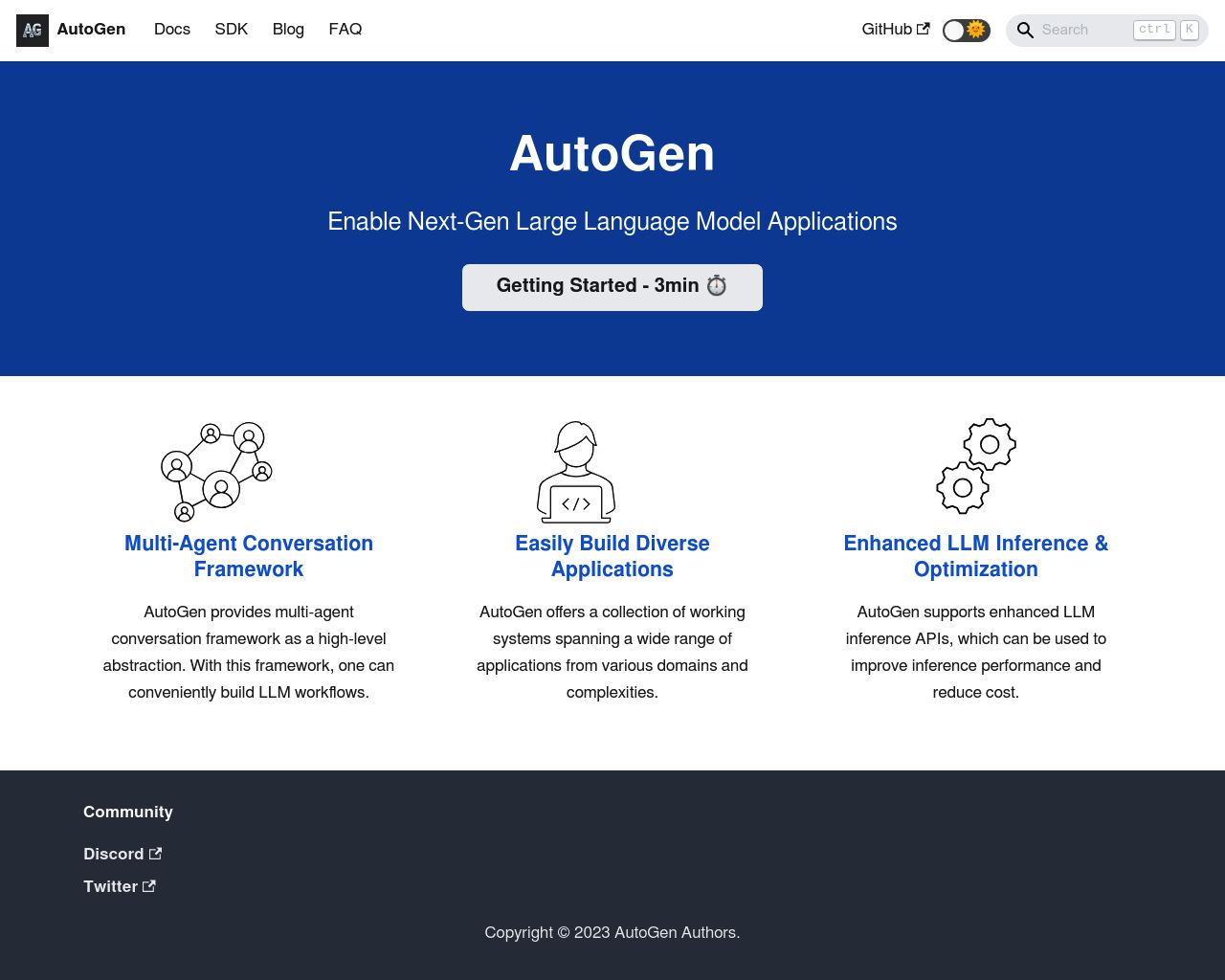AgentGPT vs AutoGen: A Comprehensive Comparison in the AI Industry
AI agent development platforms revolutionize how businesses and developers harness artificial intelligence. AgentGPT and AutoGen offer unique approaches to creating autonomous AI agents, each with distinct strengths and limitations. AgentGPT provides a web-based interface for building goal-oriented agents, while AutoGen focuses on multi-agent conversations for complex problem-solving. This comparison explores their key features, use cases, and overall effectiveness. We’ll also introduce SmythOS, a comprehensive alternative that combines the best aspects of both platforms while addressing their shortcomings. Whether you’re a developer seeking powerful AI tools or a business leader looking to integrate AI into your operations, this analysis will help you make an informed decision about the right platform for your needs.
AgentGPT Overview
AgentGPT revolutionizes AI development by offering an open-source platform for creating and deploying autonomous AI agents. Unlike traditional chatbots, AgentGPT focuses on goal-oriented tasks, enabling users to build agents capable of complex problem-solving and autonomous operation.
AgentGPT revolutionizes AI development by offering an open-source platform for creating and deploying autonomous AI agents… capable of complex problem-solving and autonomous operation.


The platform shines in its versatility, catering to developers, businesses, and AI enthusiasts alike. AgentGPT’s web-based interface allows users to customize agents for various applications, from research and analysis to task automation. Its use of vector databases for memory management sets it apart, enabling agents to retain execution history and access long-term memory, enhancing their functionality over extended periods.
AgentGPT’s web-based interface allows users to customize agents for various applications… Its use of vector databases for memory management… enables agents to retain execution history and access long-term memory
Key features of AgentGPT include user authentication systems, the ability to save and share agent runs, and dynamic translations for multiple languages. The platform also offers AI model customization and web browsing capabilities, making it adaptable to diverse needs. For developers, AgentGPT provides robust tools for setting up and running agents locally or on servers using Docker, ensuring flexibility in deployment.
While AgentGPT offers powerful capabilities, it lacks some advanced features found in other platforms. The absence of a visual builder or no-code editor may pose challenges for non-technical users. Additionally, the platform doesn’t explicitly mention features for explainability, transparency, or debug modes, which could be crucial for users requiring detailed insights into agent decision-making processes.
Despite these limitations, AgentGPT’s commitment to open-source development and its integration with tools like LangChain position it as a valuable resource in the AI ecosystem. The platform’s scalability and cloud offering make it suitable for both individual projects and enterprise-level applications, reflecting its potential to drive innovation across various industries.
AutoGen Overview
AutoGen empowers developers to create sophisticated Large Language Model (LLM) applications through multi-agent conversations. This open-source framework enables customizable agents to interact with each other, LLMs, tools, and humans to tackle complex tasks.


AutoGen’s core strength lies in its multi-agent conversation capabilities. These agents collaborate autonomously or with human input to solve diverse problems. The framework maximizes LLM performance through enhanced inference features like tuning, caching, and error handling. This optimization proves crucial when working with resource-intensive models such as GPT-4.
AutoGen empowers developers to create sophisticated Large Language Model (LLM) applications through multi-agent conversations.
Developers can tailor AutoGen’s agents to specific needs, integrating LLMs, human inputs, and various tools. The platform supports both fully autonomous operations and human-in-the-loop problem-solving, offering flexibility for applications requiring human oversight. AutoGen has demonstrated effectiveness across a wide range of use cases, from automated task solving and code generation to complex problem-solving in group chats.
While AutoGen offers powerful capabilities, it lacks some features found in more comprehensive platforms. It doesn’t provide a visual builder or no-code editor, which may limit accessibility for non-technical users. Additionally, the framework doesn’t explicitly mention features for explainability, transparency, or debug modes, which could be valuable for troubleshooting complex agent interactions.
AutoGen integrates with existing tools and systems through its flexible architecture. The framework uses Docker for environment setup, enabling compatibility across various platforms. However, specific details on integration with third-party services or APIs are not extensively documented, potentially requiring additional effort from developers to establish connections with external systems.
Feature Comparison
AgentGPT and AutoGen both offer powerful capabilities for building AI agents, but with some key differences. AgentGPT focuses on creating autonomous agents through a web-based interface, while AutoGen emphasizes multi-agent conversations and collaboration. AgentGPT uses vector databases for memory management, allowing agents to retain execution history. AutoGen, on the other hand, excels in facilitating conversations between multiple customizable agents to solve complex tasks. While AgentGPT provides user authentication and the ability to save agent runs, AutoGen offers enhanced LLM inference features like tuning and caching. Neither platform provides a visual builder or no-code editor, potentially limiting accessibility for non-technical users. Both lack explicit features for explainability, transparency, and debugging, which could hinder troubleshooting complex agent interactions. In terms of security, AgentGPT mentions OAuth authentication, but AutoGen’s documentation doesn’t highlight specific security measures. AutoGen’s flexibility in customizing agents for different tasks and its support for both autonomous and human-in-the-loop operations give it an edge in versatility. However, AgentGPT’s web-based deployment may offer easier setup for some users. Overall, while both platforms provide valuable tools for AI agent development, they cater to different use cases and levels of technical expertise.
Feature Comparison Table
| AgentGPT | AutoGen | SmythOS | |
|---|---|---|---|
| CORE FEATURES | |||
| Visual Builder | ❌ | ❌ | ✅ |
| No-Code Options | ❌ | ❌ | ✅ |
| Explainability & Transparency | ❌ | ✅ | ✅ |
| Human-AI Interaction | ❌ | ✅ | ✅ |
| Agent Work Scheduler | ✅ | ❌ | ✅ |
| SECURITY | |||
| Constrained Alignment | ❌ | ❌ | ✅ |
| IP Control | ❌ | ❌ | ✅ |
| COMPONENTS | |||
| Foundation AIs | ❌ | ✅ | ✅ |
| Data Lakes | ❌ | ❌ | ✅ |
| DEPLOYMENT OPTIONS (EMBODIMENTS) | |||
| Staging Domains | ❌ | ❌ | ✅ |
| Production Domains | ❌ | ❌ | ✅ |
| Deploy as Scheduled Agent | ❌ | ❌ | ✅ |
| DATA LAKE SUPPORT | |||
| Hosted Vector Database | ✅ | ❌ | ✅ |
| Sitemap Crawler | ❌ | ❌ | ✅ |
| YouTube Transcript Crawler | ❌ | ❌ | ✅ |
Best Alternative to AgentGPT and AutoGen
SmythOS stands out as the superior alternative to AgentGPT and AutoGen, offering a comprehensive and user-friendly platform for AI agent development and deployment. Our visual builder and no-code options make agent creation accessible to users of all technical backgrounds, a feature notably absent in both AgentGPT and AutoGen. This democratization of AI technology allows businesses to leverage advanced AI capabilities without extensive programming knowledge.
SmythOS stands out as the superior alternative to AgentGPT and AutoGen, offering a comprehensive and user-friendly platform for AI agent development and deployment.
We provide unparalleled flexibility in deployment options, including staging and production domains, scheduled agents, and integration with popular AI platforms. This versatility surpasses the limited deployment capabilities of AgentGPT and AutoGen, enabling seamless incorporation of AI agents into existing workflows and systems.
Our platform excels in security and scalability, offering features like constrained alignment and IP control that are missing from both AgentGPT and AutoGen. These enhancements ensure that AI agents operate within defined parameters and maintain data integrity, critical for enterprise-level applications.
SmythOS’s comprehensive data lake support, including a hosted vector database and various data crawlers, outperforms both competitors. This robust data handling capability allows for more sophisticated and context-aware AI agents, enhancing their problem-solving abilities across diverse use cases.
By choosing SmythOS, users gain access to a cutting-edge AI agent builder that combines ease of use with powerful features, offering unlimited potential for innovation and efficiency across industries. Our platform not only matches but exceeds the capabilities of AgentGPT and AutoGen, making it the ideal choice for businesses looking to harness the full potential of AI technology.
Conclusion
AgentGPT and AutoGen offer powerful capabilities for AI agent development, each with unique strengths. AgentGPT excels in creating autonomous agents through a user-friendly web interface, while AutoGen shines in facilitating multi-agent conversations for complex problem-solving. Both platforms cater to developers and AI enthusiasts, providing tools for customization and deployment.
However, SmythOS emerges as the superior choice, offering a comprehensive solution that addresses the limitations of both AgentGPT and AutoGen. Our platform combines the best of both worlds, featuring a drag-and-drop interface for easy agent creation, extensive integration capabilities, and support for multi-agent collaboration. SmythOS’s visual builder and no-code editor make AI development accessible to a broader audience, including non-technical users.
Unlike AgentGPT and AutoGen, SmythOS provides robust features for explainability, transparency, and debugging. These capabilities are crucial for businesses requiring detailed insights into agent decision-making processes. Our platform also offers advanced security measures, including data encryption and OAuth support, ensuring your AI applications meet enterprise-grade standards.
If you’re looking to harness the full potential of AI agents for your business or projects, we invite you to explore our diverse range of AI-powered agent templates. These templates cover multiple business categories and are designed to streamline processes across various functions. To experience the power of SmythOS firsthand, create a free account and start building AI agents with no time limit. Join us in revolutionizing AI development and deployment – try SmythOS today and unlock the future of AI-driven innovation.
Last updated:
Disclaimer: The information presented in this article is for general informational purposes only and is provided as is. While we strive to keep the content up-to-date and accurate, we make no representations or warranties of any kind, express or implied, about the completeness, accuracy, reliability, suitability, or availability of the information contained in this article.
Any reliance you place on such information is strictly at your own risk. We reserve the right to make additions, deletions, or modifications to the contents of this article at any time without prior notice.
In no event will we be liable for any loss or damage including without limitation, indirect or consequential loss or damage, or any loss or damage whatsoever arising from loss of data, profits, or any other loss not specified herein arising out of, or in connection with, the use of this article.
Despite our best efforts, this article may contain oversights, errors, or omissions. If you notice any inaccuracies or have concerns about the content, please report them through our content feedback form. Your input helps us maintain the quality and reliability of our information.
